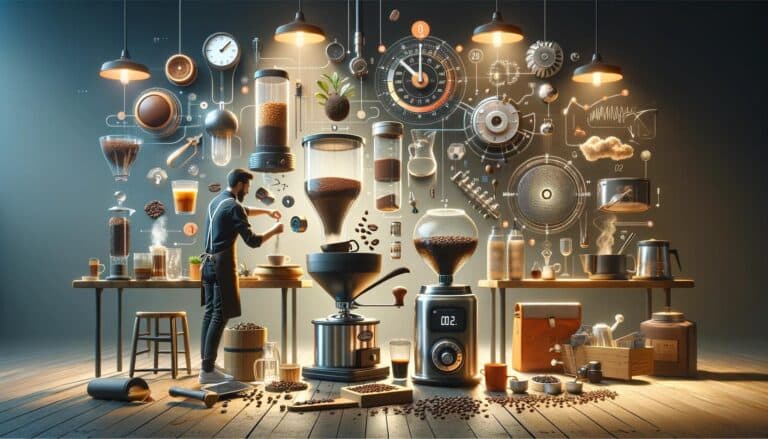Espresso isn’t just any coffee drink; it stands as a proud symbol of Italian culture and a key player on the global coffee stage. It has traveled from being a simple drink to becoming a cultural treasure, mixing history, tradition, and innovation along the way. Let’s dive into the fascinating story of espresso and see how it’s become so important in coffee culture.
What is an Espresso?
Espresso is a highly concentrated coffee made by forcing nearly boiling water through finely-ground coffee beans. It serves as the foundation for many other coffee drinks, such as Lattes and cappuccinos, and is distinguished by its strong flavor and creamy texture. The process creates a rich crema on top, enhancing its aroma and taste, making it more intense than other brewing methods.
Brief History of Espresso
In the early 20th century in Italy, the story of espresso began. The name “espresso” comes from the Italian word for “express,” reflecting not just the quick way it’s made but also that it’s crafted specially for the person who orders it. Luigi Bezzera gets the credit for inventing the espresso machine in 1901, aiming to cut down the coffee brewing time for his employees. His machine pushed hot water through coffee grounds fast, making a strong, concentrated coffee in no time.
As years passed, the espresso machine got better and better, thanks to the efforts of inventors like Desiderio Pavoni, who helped make espresso machines a hit. In the 1940s, Achille Gaggia introduced the lever-operated espresso machine, a game-changer that made the creamy layer we all love on top of a good espresso possible.
The Cultural Significance of Espresso in Coffee Culture
In Italy, espresso is much more than a morning drink; it’s a cherished break, a moment of joy to enjoy solo or with friends. Espresso bars across Italy and the globe are where people meet to chat about life, politics, and everything else over a cup of espresso.
The way people enjoy espresso has crossed over Italy’s borders, changing coffee culture worldwide. Nowadays, people don’t just love espresso for its bold taste and strength but also for how versatile it is. It’s the base for many beloved coffee drinks like lattes, cappuccinos, and Americanos, making it a must-have on any coffee shop’s menu.
What’s more, making espresso has turned into an art form. Baristas all over are always trying to perfect their craft and presentation. Espresso competitions and barista championships showcase the talent, accuracy, and creativity that go into making espresso, raising its profile even more in the coffee community. The journey of espresso, from its simple beginnings in Italy to becoming a worldwide sensation, shows how deeply it’s woven into the fabric of coffee culture, continuing to enchant and inspire as a cornerstone of coffee love.
The Basics of Espresso
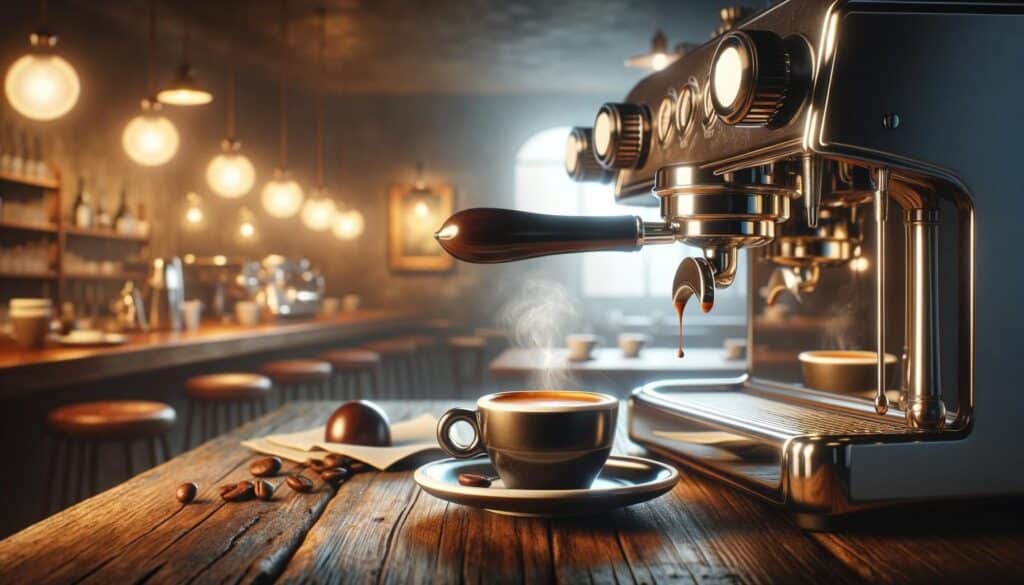
Espresso holds a special spot in the coffee world, acting both as a unique way to brew coffee and a specific kind of coffee drink. It stands out with its deep flavor, thick form, and the special crema on top. Let’s dive into what espresso is all about and what makes it different from other coffee drinks.
What Espresso Is All About
Espresso is a way to make coffee by pushing a small amount of nearly boiling water through very fine coffee grounds. This method whips up a strong, concentrated drink that’s bolder than your usual cup of coffee. A top-notch espresso has a few key features:
- Concentration: Espresso packs a lot of flavors into a tiny serving, making it more concentrated than other coffee drinks.
- Crema: This is the golden, creamy layer on top of an espresso, created when the oils in the coffee beans mix with air under high pressure.
- Flavor and Aroma: Espresso hits you with a rich mix of tastes and smells, from fruity to chocolaty to nutty, depending on the beans.
- Texture: Espresso is thicker and more syrup-like compared to regular coffee.
How Espresso Stands Apart
Espresso lays the groundwork for many beloved coffee drinks but shines on its own because of its special brewing method and qualities. Here’s what sets it apart from the rest:
- Brewing Technique: Espresso needs a special machine that extracts the coffee under high pressure, unlike drip coffee, French press, or cold brew methods. This pressure is crucial for that signature crema and intense flavor.
- Serving Size: Since it’s so concentrated, espresso comes in small doses (about 1 ounce per shot), while other coffees fill up bigger cups or mugs.
- Flavor Profile: Espresso’s concentrated form means its flavors are more bold and complex than other coffee types, which might water down the taste.
- Speed of Preparation: With an espresso machine, you can get a shot ready in less than 30 seconds, making it a faster choice than many other brewing techniques that need more time to draw out the flavors.
Espresso’s unique brewing and serving ways have made it a must-have in coffee shops and a major player in coffee culture around the globe. Whether you enjoy it straight or as the heart of a latte or cappuccino, espresso is celebrated for its intense flavor, aroma, and flexibility.
The Making of Espresso
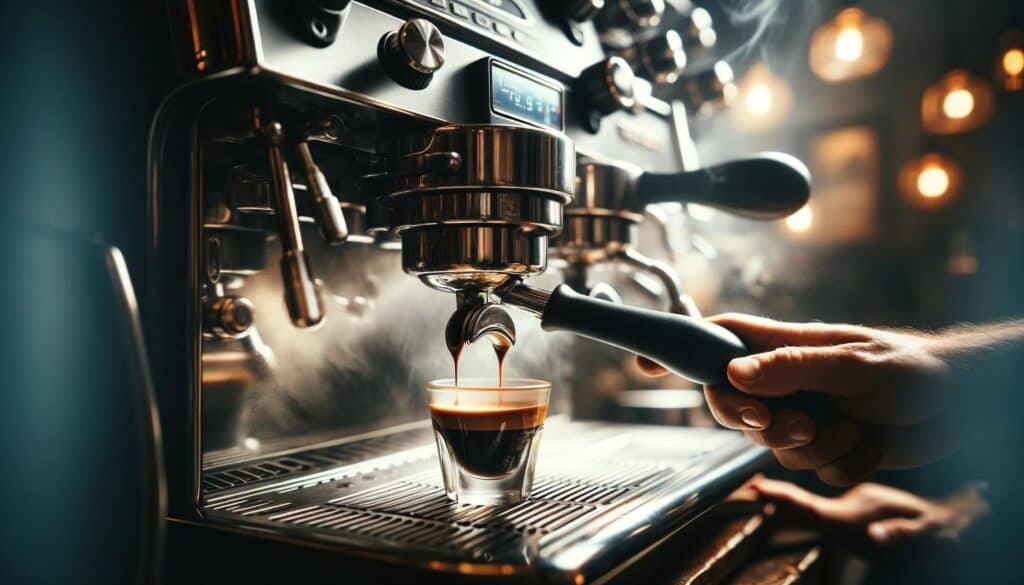
Creating the perfect shot of espresso is an art that combines the right equipment, high-quality coffee beans, and a precise brewing process. This section dives into the essentials of making espresso, from the equipment needed to the importance of coffee bean selection and the steps involved in the brewing process.
Essential Equipment: Espresso Machine and Grinder
- Espresso Machine: The heart of the espresso-making process, this machine uses high pressure to force hot water through finely ground coffee beans. There are various types of espresso machines, including manual lever, semi-automatic, automatic, and super-automatic, each offering different levels of control and convenience to the user.
- Grinder: A high-quality grinder is crucial for achieving the fine, consistent grind size required for espresso. Burr grinders are preferred over blade grinders, as they provide a more uniform grind, ensuring even extraction and a balanced flavor profile.
The Role of Coffee Beans: Varieties and Roasting
- Varieties: The choice of coffee bean variety (Arabica or Robusta, or a blend of both) can significantly affect the flavor, acidity, body, and crema of the espresso. Arabica beans are known for their sweeter, more complex flavor profiles, while Robusta beans offer a stronger, more bitter taste and a thicker crema.
- Roasting: The roast level of the beans also plays a vital role in determining the taste of the espresso. Dark roasts are traditionally used for espresso due to their bold, rich flavor and lower acidity. However, medium roasts are becoming increasingly popular for their ability to highlight the unique characteristics of the coffee’s origin.
The Brewing Process: From Bean to Espresso
- Grinding the Beans: Begin by grinding fresh coffee beans to a fine consistency, similar to table salt. The grind size is critical – too coarse, and the water will flow through too quickly, resulting in a weak espresso; too fine, and the shot may be over-extracted and bitter.
- Dosing and Tamping: Measure the correct amount of ground coffee into the espresso machine’s portafilter. This amount can vary but is typically around 18 grams for a double shot. Tamp the grounds evenly and firmly to ensure a uniform extraction.
- Brewing: Lock the portafilter into the espresso machine and start the brew cycle. A good espresso shot will take about 25-30 seconds to brew. During this time, water heated to around 200°F (about 90°C) is forced through the grounds at 9-10 atmospheres of pressure.
- Observing the Shot: Watch the espresso as it pours into the cup. It should start with a dark, rich stream and gradually lighten to a golden brown. This process is often referred to as the “ratios tail” and indicates a proper extraction.
- Serving: Serve the espresso immediately to enjoy its full aroma and flavor, ideally in a warmed espresso cup to maintain its temperature.
Mastering the making of espresso requires practice and patience. Adjusting the grind size, dose, and tamp pressure, as well as experimenting with different beans and roast profiles, can help in fine-tuning the process to achieve the perfect shot.
The Science of Espresso
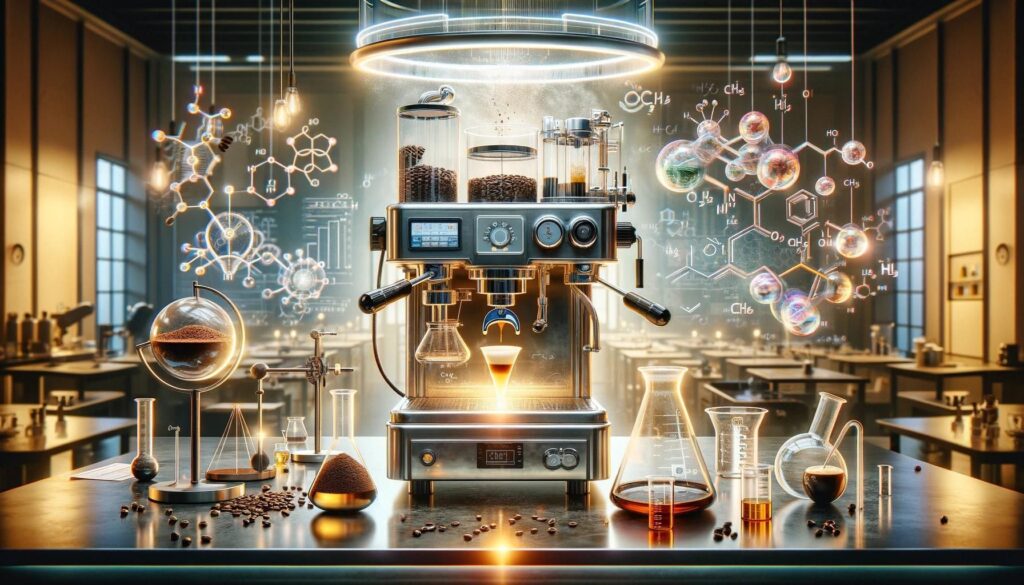
Making espresso is both a science and an art. When you get into the chemistry of pulling an espresso shot and what changes its taste and smell, both baristas and coffee fans can make their espresso even better. Let’s look at the cool science that turns a simple coffee bean into a rich and delicious espresso.
The Science Behind Pulling an Espresso Shot
Pulling an espresso shot is all about finding the right mix of dissolving the right stuff from the coffee and letting the water flow through the grounds to make the final drink. Here’s what gets pulled out of the coffee grounds:
- Caffeine: This wakes you up but doesn’t do much for the taste.
- Oils: These add to the espresso’s feel in your mouth and create the crema on top.
- Acids: These make the espresso bright and a bit sharp, adding to its complex taste.
- Sugars: These get sweeter when you roast the beans and help make the espresso full-bodied.
- Melanoidins: These come out during roasting, giving espresso its dark color and adding bitterness and depth.
The aim is to pull the shot just right, so you get all the good flavors without pulling out the bitter or sour bits. This perfect spot is usually when you’ve extracted about 18-22% of what’s in the coffee grounds.
What Changes Espresso’s Taste and Smell
Several things can change how an espresso tastes and smells:
- Grind Size: A finer grind means more coffee touches the water, which can make the shot stronger. But if it’s too fine, it might taste bitter.
- Water Temperature: The best shots happen around 200°F. Too hot, and you might get a bitter taste. Too cool, and it might taste weak.
- Pressure: Espresso machines should push water through the grounds at about 9 bars of pressure. This helps make the crema and get the best flavors out.
- Brew Time: A good shot takes about 25 to 30 seconds. If it’s too quick or too slow, it won’t taste right.
- Coffee Bean Type and Roast: Where the beans come from, their type, and how dark they’re roasted really affect your espresso. Dark roasts are strong and bold, while light roasts are more acidic and subtle.
- Freshness: Using beans that were just roasted and grinding them right before you brew makes a big difference in taste.
Knowing and adjusting these things lets baristas bring out specific tastes and smells, making every espresso shot not just consistent but also customized to what you like. The science behind espresso is complex but super interesting, with lots of chances to try new things and find your perfect shot.
Variations of Espresso
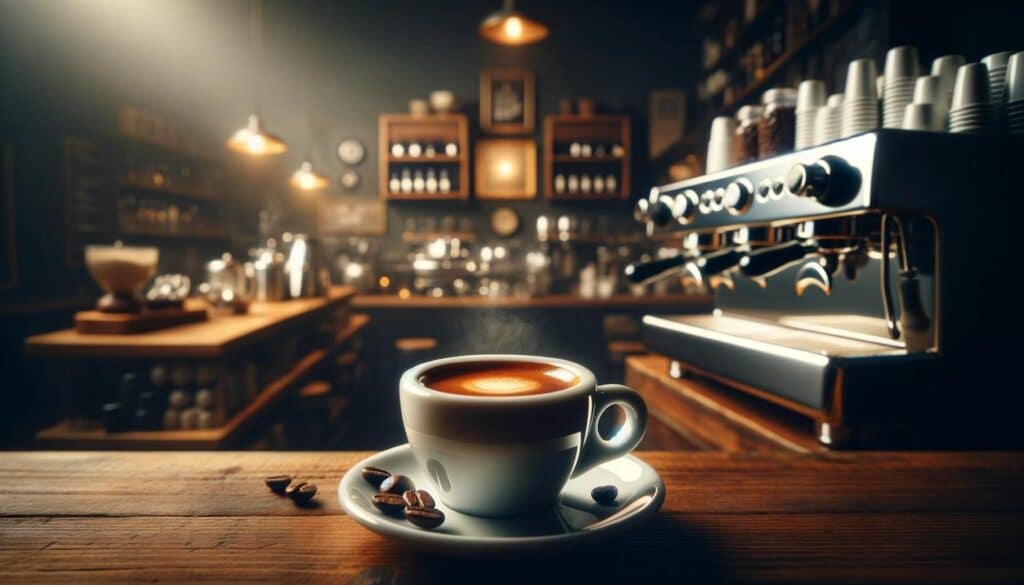
Espresso serves as both a standalone drink and a foundation for a variety of popular coffee beverages. From the straightforward single or double shot to the myriad espresso-based drinks enjoyed worldwide, the versatility of espresso is unmatched. Additionally, regional variations and specialties add unique flavors and traditions to the global coffee culture. This section explores these different expressions of espresso.
Straight Espresso: Single and Double Shots
- Single Shot (Solo): A single shot of espresso typically involves about 7 grams of ground coffee and yields roughly 1 ounce (about 30 milliliters) of drink. It’s the base unit of espresso and is perfect for those who appreciate the intense and pure flavor of coffee.
- Double Shot (Doppio): A double shot uses roughly 14 grams of coffee to produce about 2 ounces (about 60 milliliters) of espresso. It’s become the standard serving at many coffee shops, offering a stronger flavor and more caffeine.
Espresso-Based Drinks
Espresso forms the base of numerous beloved coffee drinks, each with its own unique combination of ingredients:
- Cappuccino: Equal parts espresso, steamed milk, and frothed milk, a cappuccino is distinguished by its creamy texture and strong espresso foundation, often served with a dusting of cocoa powder or cinnamon on top.
- Latte: A latte combines espresso with a larger quantity of steamed milk and a light layer of froth, making it creamier and less intense than a cappuccino, ideal for those who prefer a milder coffee flavor.
- Americano: Made by diluting a shot of espresso with hot water, an Americano retains the richness of espresso but with a lighter body, similar to that of traditionally brewed coffee.
- Macchiato: The term macchiato means “stained” or “spotted” in Italian, referring to an espresso “stained” with a small amount of frothed milk. It offers a slightly milder flavor than a straight shot of espresso.
- Mocha: A chocolate-flavored variant, combining espresso with hot milk and chocolate, usually topped with whipped cream. It’s a favorite among those who enjoy a sweet, indulgent coffee drink.
Regional Variations and Specialties
Different cultures have adapted espresso to create unique local specialties:
- Café Cubano (Cuban Coffee): A sweet espresso shot that’s whipped with sugar during the brewing process, resulting in a thick, sweet crema.
- Affogato: An Italian dessert coffee that involves pouring a shot of hot espresso over a scoop of vanilla gelato or ice cream, creating a rich and refreshing treat.
- Flat White: Originating from Australia/New Zealand, a flat white is similar to a latte but with a higher ratio of coffee to milk, served in a smaller cup, and with a velvety microfoam.
- Café au Lait: Popular in France, café au lait is similar to a latte but made with brewed coffee instead of espresso, mixed with an equal amount of steamed milk.
These variations and specialties reflect the global adaptability and popularity of espresso, demonstrating how different cultures have embraced and personalized the espresso experience. Whether enjoyed in its pure form or as the base of a more complex beverage, espresso continues to be a central element of coffee culture around the world.
How to Enjoy Espresso

Espresso is not just a drink; it’s an experience. Appreciating its depth involves understanding how to discern its complex flavors and aromas, how to pair it with food to enhance your culinary experience, and how to immerse yourself in the ritual of its consumption. This section offers insights into fully enjoying espresso, turning each sip into a moment of pleasure.
Tasting Notes: Identifying Flavors and Aromas
Espresso tasting, similar to wine tasting, is an art that reveals the intricate balance of flavors and aromas inherent in coffee. Here are some steps to help identify these sensory components:
- Smell: Before tasting, inhale the aroma of the espresso. A well-prepared espresso should have a potent and inviting smell. Try to identify whether it’s floral, fruity, nutty, or has chocolate undertones.
- Sip: Take a small sip and let it linger on your tongue. Espresso has a full body with a rich, creamy texture. Pay attention to the initial flavors that hit your palate.
- Taste: As you taste, consider the balance of sweetness, acidity, and bitterness. A balanced espresso should have a little bit of each, with none overpowering the others.
- Aftertaste: After swallowing, note the aftertaste that remains. Good quality espresso leaves a pleasant and lingering aftertaste that may change slightly as it fades.
Developing a keen sense of taste and smell for espresso can enhance your appreciation of its complexity and the skill involved in its preparation.
Pairing Espresso with Food
Pairing espresso with food can elevate both the drink and the dish, creating a harmonious culinary experience. Here are a few pairing suggestions:
- Sweet Pastries: Croissants, scones, or sweet breads complement the intensity of espresso with their buttery and sweet flavors.
- Chocolate: Dark chocolate or chocolate-based desserts like tiramisu can enrich the experience, as the bitterness of the chocolate harmonizes with the espresso’s flavors.
- Nuts: Almonds, hazelnuts, or nut-based pastries can pair beautifully with espresso, echoing its nutty undertones.
- Cheese: Try pairing espresso with aged cheeses like Parmigiano-Reggiano to explore a contrast of flavors that can be surprisingly delightful.
The Ritual of Drinking Espresso
In many cultures, especially in Italy, drinking espresso is a ritual that marks different moments of the day, a pause for pleasure and reflection. Here’s how to immerse yourself in this ritual:
- Time of Day: While espresso can be enjoyed at any time, many prefer it in the morning for a burst of energy or after meals as a digestive aid.
- The Right Cup: Serve espresso in a small, preheated ceramic cup to maintain its optimal temperature and aroma.
- Savor the Moment: Drinking espresso should not be rushed. Take a moment to enjoy the aroma, appreciate the crema, and savor each sip, allowing the flavors to unfold.
Embracing the ritual of espresso involves more than just drinking; it’s about appreciating the moment, the company, and the drink itself. Whether you’re starting your day with a shot of espresso or ending a meal with it, taking the time to enjoy it fully can transform a simple coffee break into a memorable experience.
Making Espresso at Home
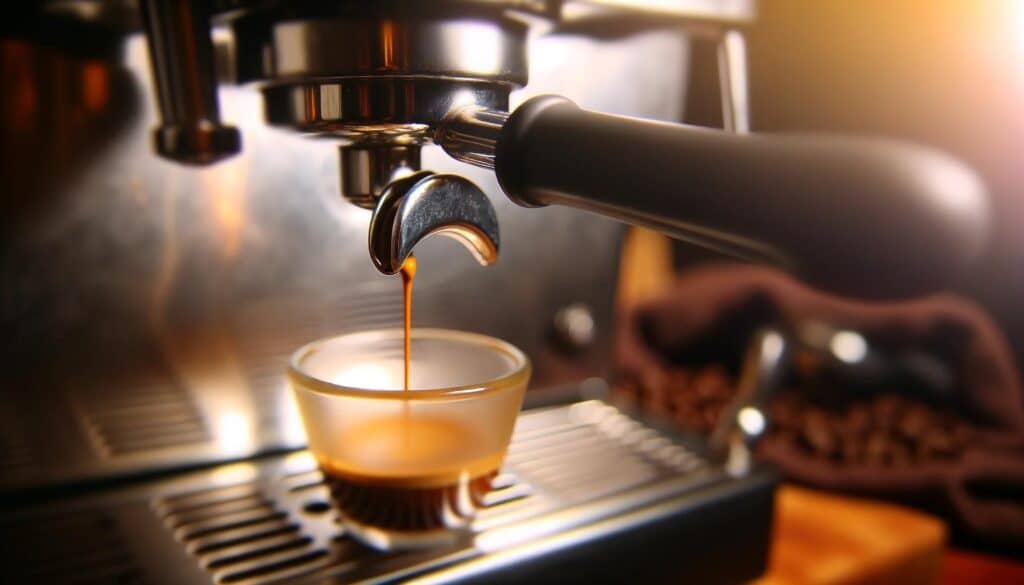
Creating espresso at home can transform your coffee experience, allowing you to tailor each cup to your personal taste while engaging in the art of espresso making. This guide will help you navigate the essentials of home espresso preparation, from selecting the right equipment and coffee beans to mastering the brewing process.
Choosing the Right Equipment
- Espresso Machine: The cornerstone of home espresso making. Consider your budget, kitchen space, and how hands-on you want to be. Options range from manual lever machines for the purists to fully automatic machines for convenience.
- Coffee Grinder: A quality burr grinder is crucial for achieving the fine, consistent grind needed for espresso. Look for grinders with adjustable settings to fine-tune your grind size.
- Accessories: A tamper for compressing your coffee grounds evenly, a frothing pitcher if you enjoy milk-based espresso drinks, and a coffee scale to measure your coffee and water ratio accurately are all valuable tools.
Selecting and Grinding Coffee Beans
- Bean Selection: Start with high-quality beans. While personal preference should guide your choice, fresh, whole bean coffee is non-negotiable. Experiment with different origins, varieties, and roast levels to find what you enjoy most.
- Grinding: Grind your beans immediately before brewing. The grind size should resemble fine table salt. Too fine, and your espresso may be over-extracted and bitter; too coarse, and it might be under-extracted and weak. Adjust the grind size based on the taste of your espresso shots.
Tips and Tricks for Perfecting Your Brew
- Preheat Your Equipment: Run a shot of hot water through your espresso machine and cup before brewing to ensure consistent temperature.
- Use Fresh Water: The quality of your water can significantly impact the taste of your espresso. Use filtered water if possible.
- Measure Precisely: Use a scale to measure both your coffee grounds and the amount of water. A good starting ratio is 1:2, coffee to water, adjusting based on taste.
- Tamp Evenly: Apply firm, even pressure when tamping the coffee in the portafilter to ensure an even extraction.
- Monitor Brew Time: Aim for a brew time of 25-30 seconds for a double shot. If your espresso brews too quickly, try a finer grind or a firmer tamp; if too slow, do the opposite.
- Clean Your Equipment: Regular cleaning is essential to prevent oil and residue buildup, which can affect the flavor of your espresso.
Experimentation is key to finding your perfect espresso at home. Don’t be afraid to adjust variables like grind size, coffee dose, tamping pressure, and brewing time. With practice and patience, you can craft espresso shots that rival those of your favorite café, tailored to your personal taste preferences.
Espresso in the Modern World

The popularity of espresso has grown significantly, integrating into various aspects of modern life. Its impact extends beyond taste and culture, touching on health concerns, environmental considerations, and future trends in the global coffee scene. This section explores these facets to understand espresso’s role and influence today.
Espresso and Health: Benefits and Considerations
- Benefits: Espresso contains concentrated amounts of antioxidants and nutrients, including magnesium and B vitamins. Its caffeine content can enhance mental alertness, improve mood, and boost physical performance. Moderate consumption is also associated with a reduced risk of several diseases, including Parkinson’s disease, type 2 diabetes, and certain types of cancer.
- Considerations: While espresso offers health benefits, moderation is key. Overconsumption can lead to negative effects such as anxiety, disrupted sleep patterns, and increased heart rate. It’s also worth noting that adding sugar or high-calorie syrups and creams can offset the health benefits.
The Environmental Impact of Espresso Production
- Coffee Farming: The cultivation of coffee beans has significant environmental implications, including deforestation, water use, and chemical runoff from pesticides and fertilizers. Shade-grown coffee and organic farming practices can help mitigate some of these impacts.
- Espresso Machines and Pods: The energy consumption of espresso machines and the waste generated by single-use pods are concerns for environmentally conscious consumers. Choosing energy-efficient machines, reusable pods, or traditional brewing methods can help reduce environmental footprints.
- Sustainability Initiatives: Many coffee companies are adopting sustainable practices, such as sourcing beans from fair trade and Rainforest Alliance-certified farms, which aim to improve environmental conservation and farmers’ livelihoods.
The Future of Espresso in the Global Coffee Scene
- Innovation and Technology: Advances in espresso machine technology are making high-quality coffee more accessible at home and in cafes. Innovations in coffee farming and processing are also improving sustainability and bean quality.
- Global Expansion: Espresso’s popularity continues to grow worldwide, transcending cultural boundaries. This expansion is accompanied by a greater appreciation for specialty coffee and artisanal brewing techniques.
- Sustainability and Ethical Consumption: As consumers become more environmentally and socially conscious, the demand for ethically sourced and sustainably produced coffee is likely to increase. This trend will push the industry towards more responsible practices.
- Cultural Integration and Adaptation: Espresso will continue to evolve, integrating into different cultures and giving rise to new trends and variations. The global exchange of coffee culture promotes diversity in espresso preparation and consumption.
Espresso’s journey in the modern world is one of adaptation and innovation. As it navigates health considerations, environmental impacts, and shifting consumer preferences, espresso remains a vibrant and dynamic force in the global coffee scene, with a promising future marked by sustainability, quality, and inclusivity.
Conclusion
Espresso, rich in history and deeply rooted in culture, is a key part of coffee culture worldwide. It began in early 20th-century Italy and now enjoys global popularity, rising above just being a drink to represent tradition, innovation, and community. This blend of art and science gives baristas and coffee lovers a chance to dive into various flavors, techniques, and stories.
Understanding Espresso’s Essence and Importance
Espresso offers more than a caffeine boost; it’s about the joy and social moments it brings and the daily rituals it’s part of. Its ability to stand alone or act as the foundation for many coffee drinks shows its importance in the coffee world. The detailed steps to make a perfect espresso shot, from bean selection to grinding and precise extraction, showcase the skill, passion, and creativity in every cup.
Espresso’s history and its journey across continents show how it adapts and grows, reflecting changes in how we view coffee, health, and the environment. It has driven coffee technology forward and encouraged a mindful approach to coffee making and enjoying.
Dive into the World of Espresso
The espresso world is vast and full of discoveries. Whether you’re deeply into coffee or just starting, exploring espresso culture can grow your coffee knowledge and love. Trying different beans, roasts, and brewing methods opens up new flavors and experiences. Learning about espresso’s roots and how it’s made can deepen your connection to this beloved drink.
Joining the global coffee community, through local cafes, online forums, or barista competitions, can also enrich your espresso adventure. Sharing stories, tips, and experiences with others not only expands your coffee views but also strengthens the sense of community around espresso.
In summary, espresso is more than a quick caffeine hit; it’s a door to a world filled with rich sensory experiences, cultural heritage, and moments shared with others. So, dive into the espresso universe—explore, experiment, and enjoy all the possibilities it offers.
Frequently Asked Questions about Espresso
- What is the difference between espresso and regular coffee?
- Espresso is a concentrated coffee brewed by forcing hot water through finely-ground coffee beans under high pressure, resulting in a strong, rich flavor and creamy texture topped with crema. In contrast, regular coffee is made with coarser grounds and a slower brewing process, leading to a lighter flavor and body.
- Can I make espresso without an espresso machine?
- While traditional espresso requires high pressure that is typically achieved with an espresso machine, you can make a strong, espresso-like coffee with alternatives like a stovetop Moka pot, AeroPress, or French press by adjusting the grind size and brewing time to mimic the intensity of an espresso shot.
- How much caffeine is in a shot of espresso compared to regular coffee?
- A single shot of espresso (about 1 ounce) contains approximately 63 milligrams of caffeine, whereas an 8-ounce cup of drip coffee contains about 95 milligrams. Although espresso is more concentrated, the smaller serving size means you consume less caffeine per shot compared to a full cup of coffee.
- Why is crema important in espresso?
- Crema, the creamy layer of foam on top of an espresso shot, is considered a sign of a well-extracted espresso. It is created by the emulsion of coffee oils and trapped gases and contributes to the espresso’s full flavor and aromatic experience.
- How do I choose the best coffee beans for espresso?
- The best coffee beans for espresso depend on personal taste preferences. However, for a classic espresso experience, look for fresh, high-quality beans with a medium to dark roast, which will give you a rich, balanced flavor. Experimenting with different origins and blends can help you find your preferred taste profile.





